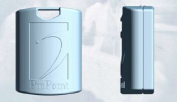Feb. 14, 2003 – RF Technologies, a Brookfield, Wis.-based provider of radio frequency tracking and location systems, has released the next version of its PinPoint Mobile Resource Manager software product. The new version allows companies to track items with either passive or active RFID tags, and data can now be accessed using a Web browser.
Like other real-time locating systems (RTLSs), PinPoint uses active (battery-powered) RFID tags to track assets in a large area. The company’s T50 tag, which is about 1.5 inches (38 mm) square, receives a 2.45 GHz signal from the antenna and transmits back to the antenna at 5.8GHz. The tags can communicate with the reader from up to 200 feet indoors and 300 feet or more outdoors.
The antenna passes data to computers that calculate the position of a tagged item to within 10 feet. Hospitals use the system to track equipment, and industrial manufacturers employ it to track work in progress or parts in a large facility.
The latest version of the product allows companies to add readers from other vendors and track assets with passive tags. A hospital could, for example, use an active tag that sends out a beacon signal to track the location of a heart defibrillator and put passive tags on folders with medical documents, or less expensive items. An industrial manufacturer might put an active tag on a car chassis and use active tags to track items attached to that particular chassis.
“Our software provides an integration layer for different types of RFID products,” says Larry Cinpinski, RF Technologies’ VP and GM for RTLS. “It’s seamless to the end user. They just see the information about where assets are located, regardless of the hardware involved.”
Another new feature of in the PinPoint upgrade is the ability to view the information using a Web browser. “The advantage is the distribution of the software is very easy,” says Cinpinski. “You install it on a server, and then it’s immediately on the desktop of anyone that has a PC with a browser.”
RF Technologies has also added the ability to scan a CAD drawing of a building and convert it into a graphical map that displays the location of assets. A hospital worker could then have the system display every tagged asset in a specific wing. An industrial manufacturer could display assets in a particular production area.
Each installation is done on a custom basis and prices for the system vary widely based on the number of tags and antennas and the type of environment. But Cinpinski says systems generally range from “$30,000 up to a couple of hundred thousand.”


